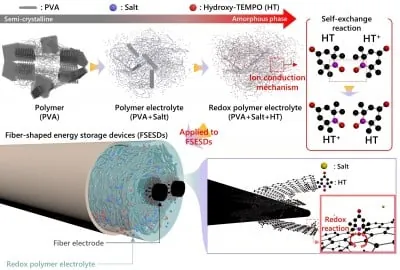
Revolutionary Breakthrough: Tiny Additives Create an Ion Highway for Future Batteries!
2025-07-16
Author: Sarah
A Game Changer in Wearable Technology
In the race for advanced wearable electronics, flexibility and size are crucial. Traditional batteries simply can't keep up, struggling with rigidity and bulkiness. However, a remarkable new technology is emerging: fiber-shaped energy storage systems that can morph into various shapes, opening the door for innovative applications.
Boosting Ionic Conductivity with a Simple Additive
A talented research team from the Korea Institute of Science and Technology (KIST) and the Korea Advanced Institute of Science and Technology (KAIST) has cracked the code for enhancing battery performance. They've developed a cutting-edge polymer electrolyte that uses a minuscule amount of an organic molecule called 4-hydroxy TEMPO (HyTEMPO). This specially engineered molecule acts like a supercharger for ionic conductivity, boosting it to an astonishing 3.2 mS/cm—an increase of about 17 times!
How Does It Work?
Think of these organic molecules as highways within the polymer. They clear the way for rapid ion transport, not only enhancing ionic mobility but also significantly improving energy storage capabilities. This innovative electrolyte achieves a remarkable storage capacity of 25.4 Wh/kg and an impressive output power of 25 kW/kg, proving that next-generation energy storage can thrive on fiber-shaped electrodes alone.
Durability Meets Flexibility
But that's not all! This new polymer has undergone rigorous testing and has shown phenomenal durability, retaining 91% of its original performance after more than 8,000 bending cycles. It even performed seamlessly when twisted into knots, making it an ideal choice for wearable devices that demand both flexibility and reliability.
Quote from the Researchers
Nam Dong Kim, the lead researcher at KIST, stated, "We've dramatically enhanced ionic conductivity with a straightforward additive approach, eliminating the need for complex processes. This breakthrough could pave the way for a new era in safe, flexible energy storage solutions." Co-researcher Yongho Joo added, "By tapping into the unique properties of radical polymers, we've successfully tackled the traditional limitations of electrolytes." He emphasized, "Our journey doesn't stop here; we're committed to pushing the boundaries of performance even further."
A Bright Future for Energy Storage!
This pioneering work isn't just a scientific feat; it's a beacon of hope for future wearable electronics, offering solutions that prioritize safety, flexibility, and energy efficiency. The potential to transform our portable devices is enormous, heralding a new chapter in the world of energy storage.




 Brasil (PT)
Brasil (PT)
 Canada (EN)
Canada (EN)
 Chile (ES)
Chile (ES)
 Česko (CS)
Česko (CS)
 대한민국 (KO)
대한민국 (KO)
 España (ES)
España (ES)
 France (FR)
France (FR)
 Hong Kong (EN)
Hong Kong (EN)
 Italia (IT)
Italia (IT)
 日本 (JA)
日本 (JA)
 Magyarország (HU)
Magyarország (HU)
 Norge (NO)
Norge (NO)
 Polska (PL)
Polska (PL)
 Schweiz (DE)
Schweiz (DE)
 Singapore (EN)
Singapore (EN)
 Sverige (SV)
Sverige (SV)
 Suomi (FI)
Suomi (FI)
 Türkiye (TR)
Türkiye (TR)
 الإمارات العربية المتحدة (AR)
الإمارات العربية المتحدة (AR)